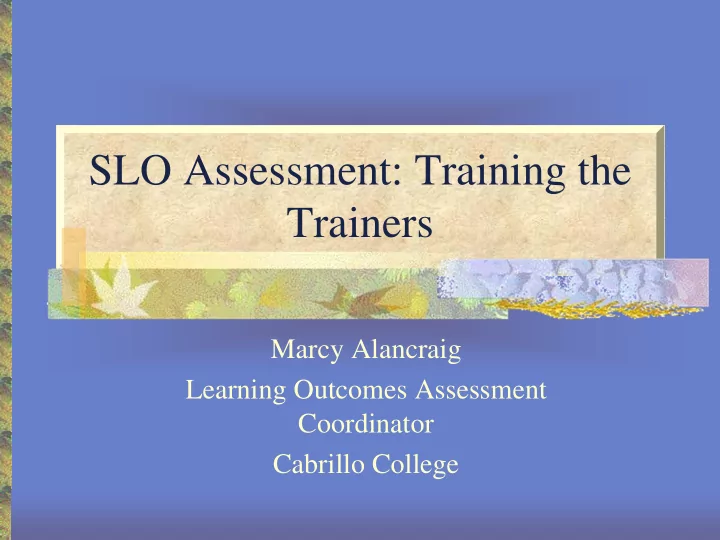

SLO Assessment: Training the Trainers Marcy Alancraig Learning Outcomes Assessment Coordinator Cabrillo College
Writing SLOs
SLOs: The Big Picture • Requires HIGHER LEVEL thinking skills • Synthesizes many discreet skills • Requires students to APPLY what they’ve learned • Results in a product • Product must be evaluated or assessed by faculty
Objective: Nuts and Bolts • Describes small, discreet skills • Requires basic thinking skills • Do not necessarily result in a product
A comparison: English 1A Objectives: SLO • Develop a main Write essays, • idea including research- based writing, • Maintain a clear demonstrating command of tone academic rhetorical • Show control of strategies and standard English documentation. grammar
Cabrillo Advice: Less is More! • Restrict SLOs to the most major skills, knowledge or attitudes • Try for no more than 3-4 at the very most! Two is better! • Remember that each SLO must be assessed!
Activity: Revise Course SLO Are there any you can • Simply? • Combine? • Edit?
SLO Assessment Methods
Key Decisions • How much time do you want to spend? • Will the assessment be something extra you require of students beyond class work? • Will the assessment be something extra you expect of faculty? • Who will analyze the results? • How will you close the feedback loop?
Reminder: • Use the KISS method • Keep it simple, sweetheart!
Course-Embedded Assessment: Expanded Grading • Assesses artifacts produced in class – papers, projects, portfolios, presentations • Uses rubrics or other explicitly stated criteria to assess • Results analyzed and presented to decision makers, resulting in decisions to improve student learning and teaching
Primary Trait Analysis • Looks at one major assignment • Instructor constructs Primary Trait Scale that scores each part of assignment • Results of each section calculated and analyzed by faculty member • Presented to department with suggestions for how to improve teaching and learning
Cabrillo KISS Variation • Instructor chooses assignment, writes rubric and grades assignment • Instructor analyzes results, looking for student issues and needs – no numbers • Presents to department – no numbers • Department discusses results overall and makes plans to improve • Discussion recorded on form that becomes part of Departmental Review
Side Benefits of Cabrillo Variation • No worries about academic freedom • No worries about evaluation • Departmental meeting becomes about teaching - assignment, rubric and results presented • Some improvement of weak faculty (maybe)
Other variations • Can have common departmental or section assignment • Can use common departmental or section rubric or PTA scale • Can have your researcher analyze grading results, but still have to get him/her the info
Portfolio Assessment • Students assemble collection of work • Faculty develop rubric to score it • Faculty are “normed” • Faculty score together outside of class • Requires extra time for norming and scoring • Can be fun!
Pre and Post Testing • Faculty design test that addresses course SLOs • Same test given to students at the beginning and end of course • Faculty or researcher scores results and compares them, analyzing to see how well students have achieved outcomes
Testing • Standardized tests • Analyzing questions on objective tests • Common paper or final • A caution: be careful of matriculation issues
More Key Decisions • Do you want different methods for each course? • Would you prefer one method used by all faculty in the department or across the entire college? • What makes sense for your college culture?
Activity • Divide into groups by divisions. • Discuss assessment methods and choose one that will work for you
Rubric Writing
Closing the Loop • What activity will you use to present assessment results? • How will this activity result in improving teaching and learning? • How will you record the results? • How will you implement them?
The Gather Assessment Evidence Loop Interpret Evidence Mission/Purposes Educational Objectives How well do we achieve our educational Enhance teaching/ objectives? learning; inform institutional decision- – Peggy Maki, making, planning, AAHE budgeting
Activity • Fill out Assessment Plan form to chart how you will close the loop!
More recommend